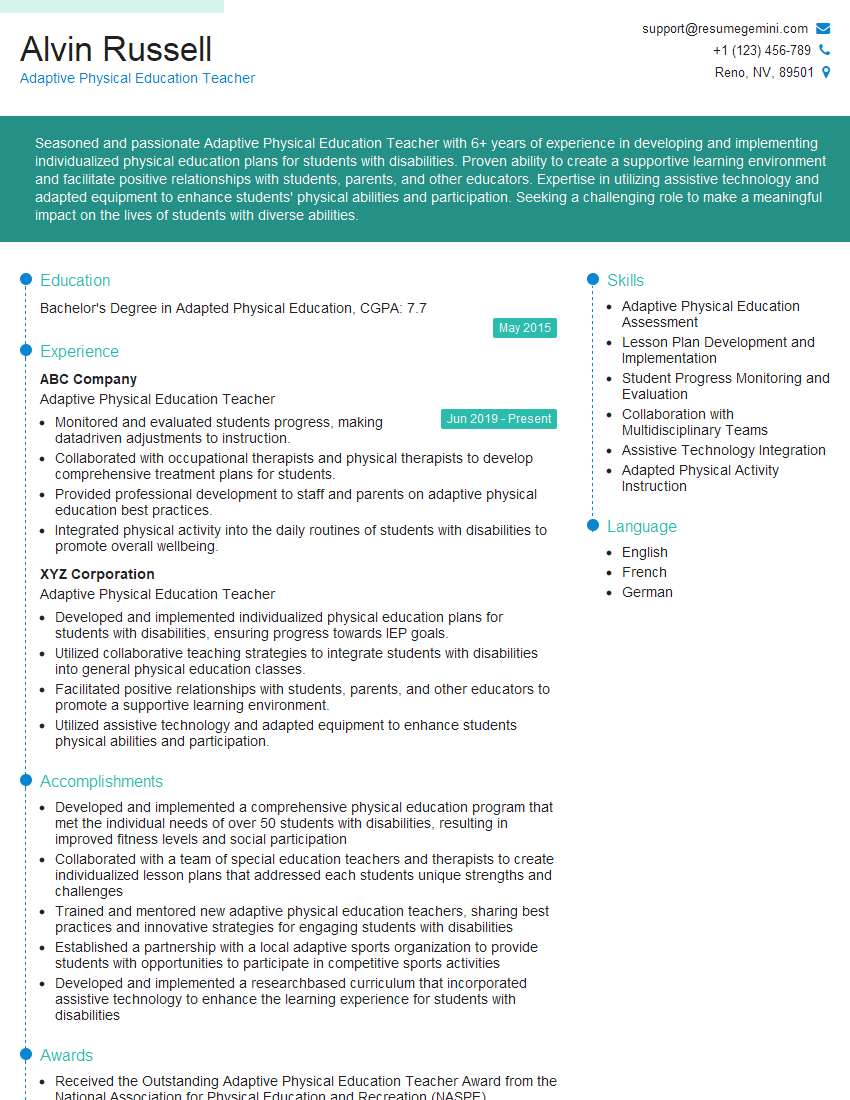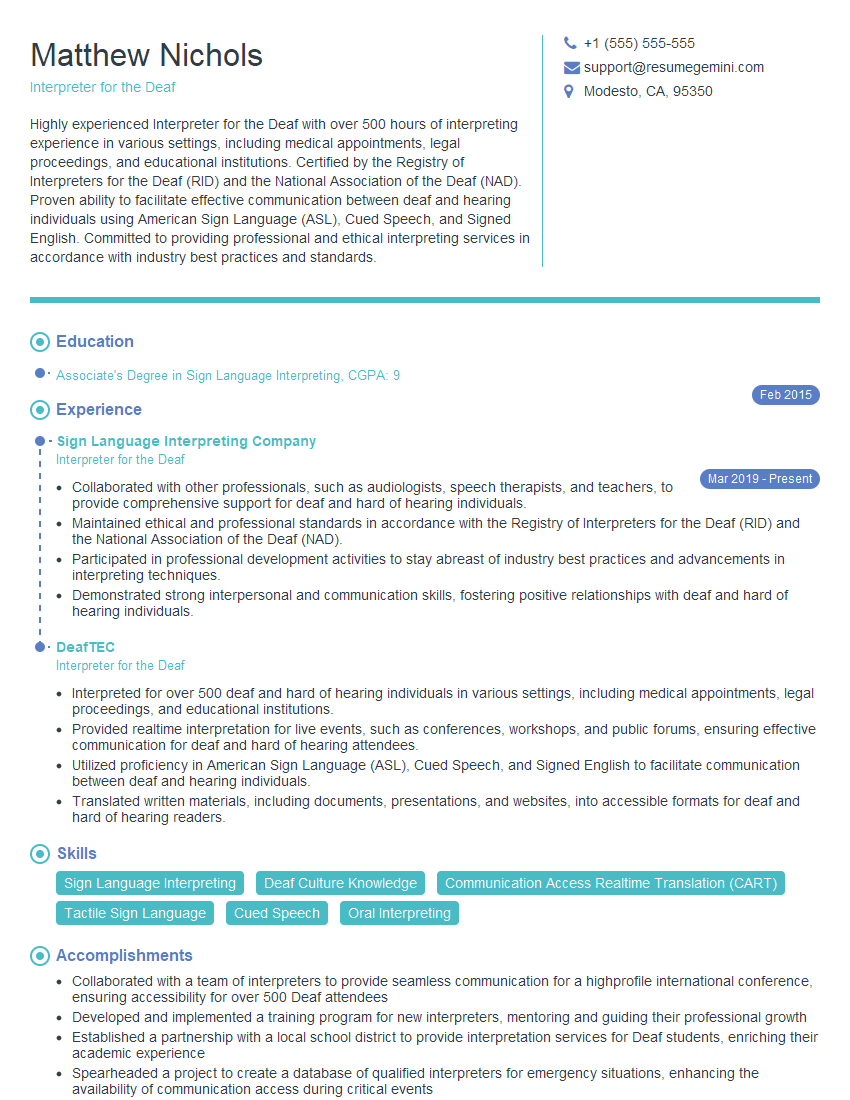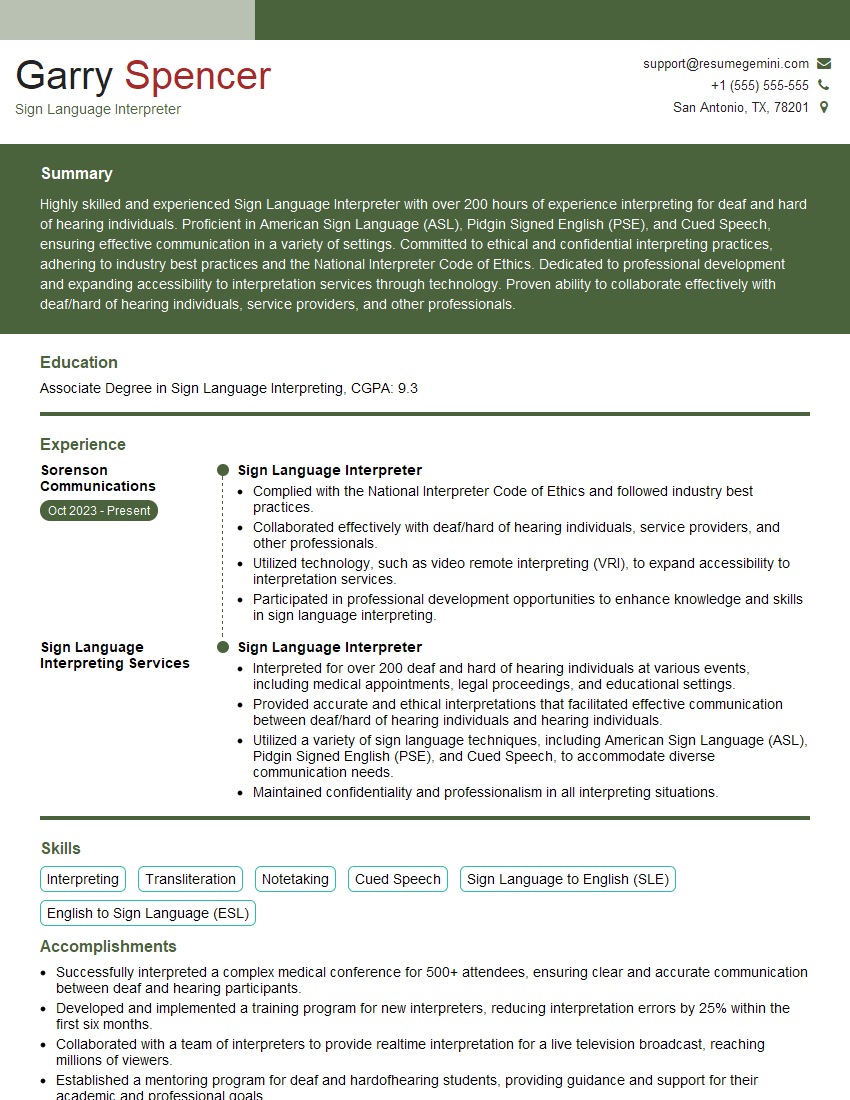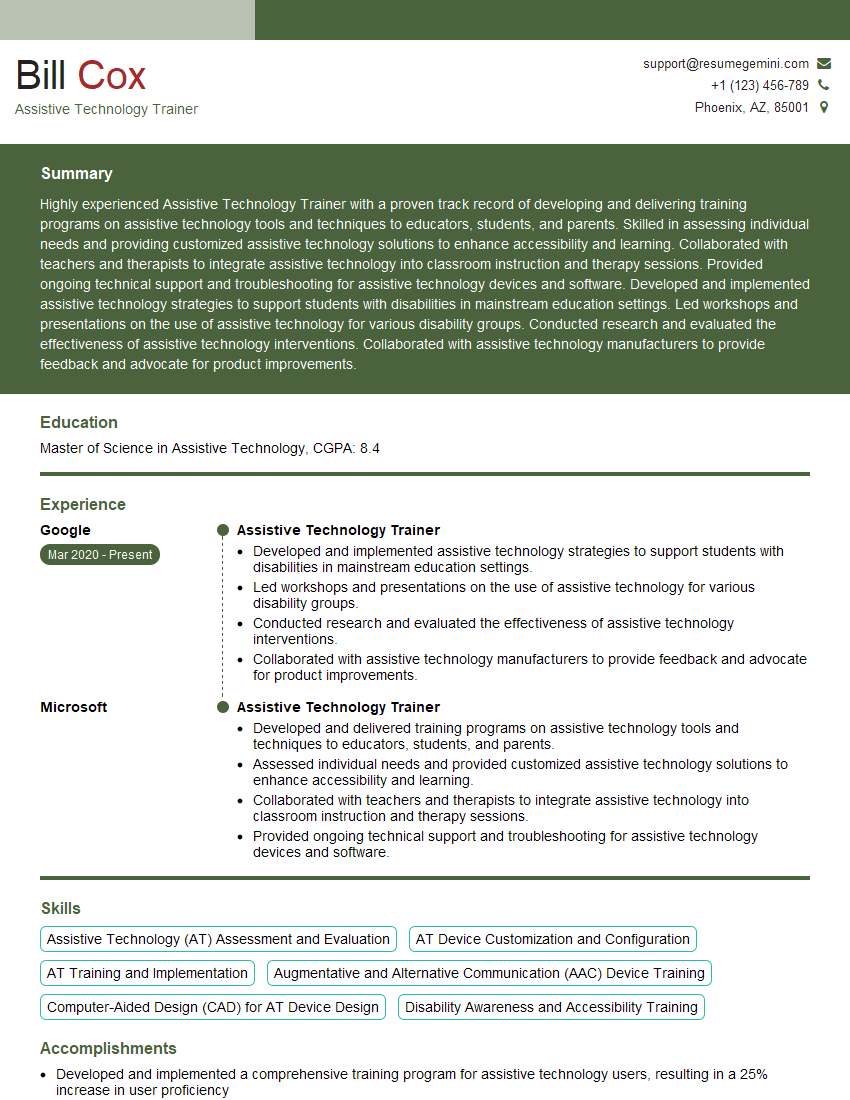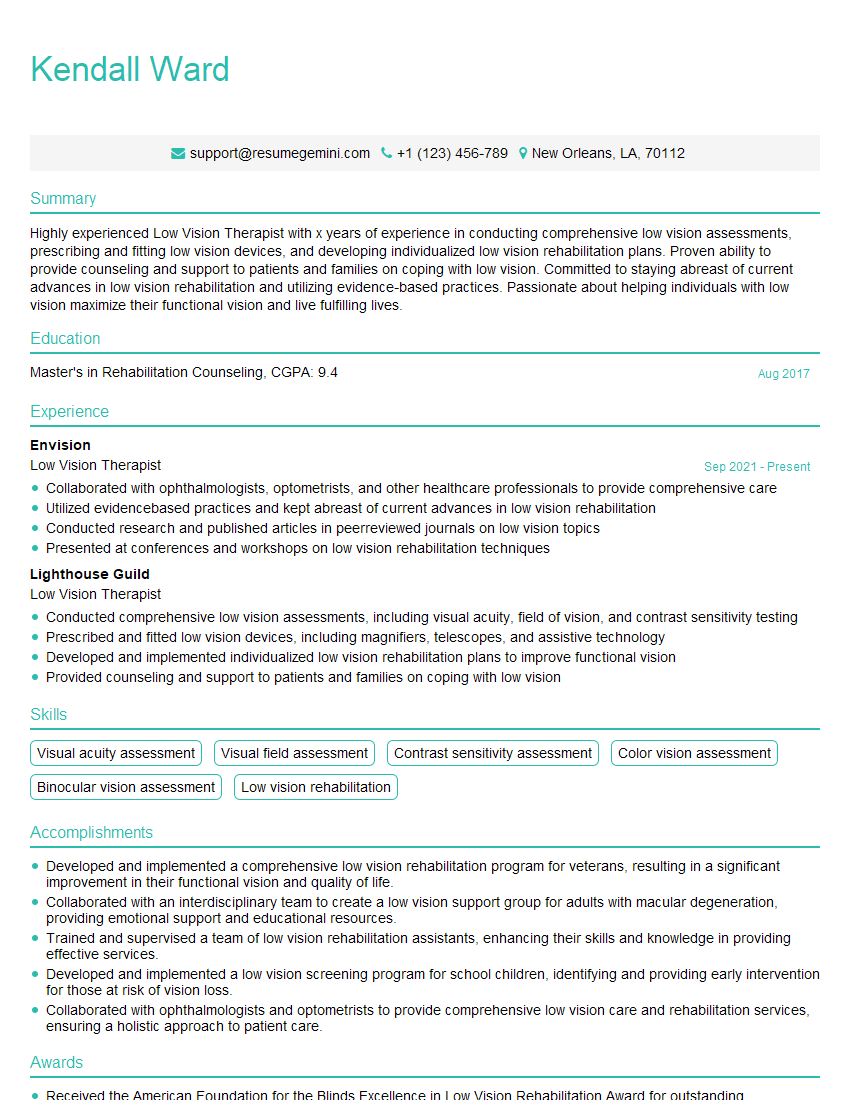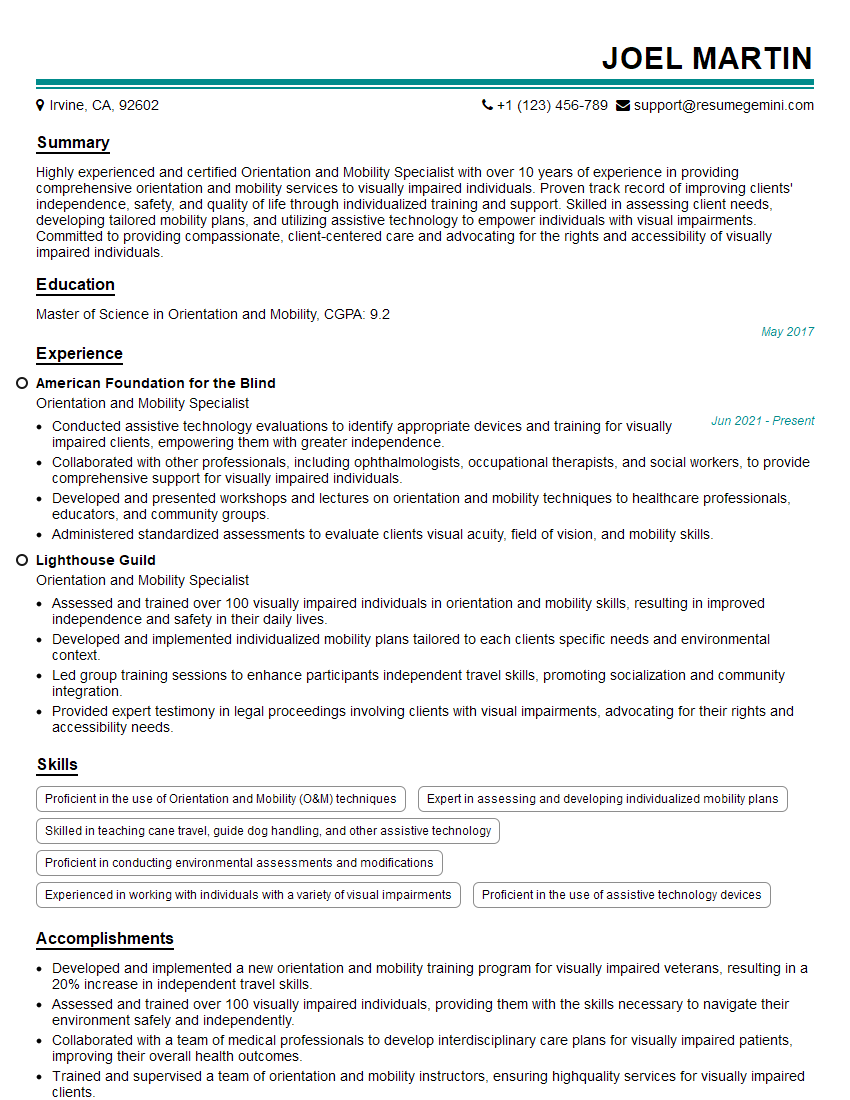Feeling uncertain about what to expect in your upcoming interview? We’ve got you covered! This blog highlights the most important Experienced in providing services to individuals with visual and hearing impairments interview questions and provides actionable advice to help you stand out as the ideal candidate. Let’s pave the way for your success.
Questions Asked in Experienced in providing services to individuals with visual and hearing impairments Interview
Q 1. Describe your experience working with individuals who have low vision.
My experience with individuals who have low vision spans over ten years, encompassing various settings from residential care to community-based rehabilitation. I’ve worked with clients experiencing a wide spectrum of vision loss, from mild impairment to total blindness. A significant portion of my work involves adapting daily living skills, teaching orientation and mobility techniques, and providing training on assistive technology. For example, I helped a visually impaired student learn to navigate a university campus using a cane and GPS technology, significantly improving their independence and confidence. Another instance involved assisting an elderly client in adapting their home environment to better suit their diminished vision, which involved installing grab bars and rearranging furniture for better accessibility. These experiences have taught me the importance of patient-centered care, adapting strategies based on individual needs and preferences, and fostering a supportive environment for personal growth and self-reliance.
Q 2. Explain different types of assistive technology for the visually impaired and their applications.
Assistive technology for the visually impaired is a diverse field offering solutions for various needs. Some key examples include:
- Screen readers: Software that reads aloud the text displayed on a computer screen, like JAWS or NVDA. This enables access to digital information and productivity tools.
- Magnifiers: These range from simple handheld magnifiers to sophisticated electronic magnifiers with adjustable magnification and lighting. They greatly enhance the ability to read print material.
- Optical character recognition (OCR) software: This software can scan printed text and convert it into digital text, which can then be read aloud by a screen reader or magnified on a screen.
- Refreshable Braille displays: These devices display text in Braille, allowing users to ‘read’ digital text through touch. They are frequently paired with screen readers.
- Smart canes and GPS navigation systems: These provide orientation and mobility assistance, enabling safe and independent travel.
The application of these technologies depends entirely on the individual’s specific needs and visual acuity. For instance, someone with mild vision loss might benefit from a large-print book and a handheld magnifier, while someone with profound vision loss may rely heavily on a screen reader, Braille display, and a smart cane.
Q 3. How would you assess a client’s needs for assistive technology?
Assessing a client’s needs for assistive technology is a multi-step process. It begins with a thorough understanding of their visual impairment, including the diagnosis, severity, and progression of the condition. This often involves reviewing ophthalmological reports and conducting a comprehensive interview. Next, I assess their daily living skills, identifying areas where assistive technology could improve their independence and quality of life. This includes evaluating their reading ability, computer skills, mobility, and ability to perform daily tasks. Finally, I consider the client’s preferences, budget, and technological literacy. A collaborative approach is essential; it’s not just about selecting the most advanced technology but about finding the tools that best fit the client’s individual needs and lifestyle. For example, a client might prefer a simpler magnifier over a complex electronic device due to ease of use. A trial period with different devices is often beneficial.
Q 4. Detail your experience with Braille literacy instruction.
I have extensive experience in Braille literacy instruction, having taught both children and adults. My approach involves a combination of tactile training and literacy development. I begin by teaching the fundamental Braille alphabet and then progress to more complex concepts like contractions and punctuation. I utilize various teaching materials, including Braille slates and styluses for writing, Braille books and flashcards for reading, and interactive software programs. Teaching Braille is not just about memorizing symbols; it’s about fostering a love of reading and empowering individuals to access information independently. I tailor my teaching style to each learner’s pace and learning preferences, creating a supportive and encouraging environment. For instance, one of my students, a young adult, initially struggled with the tactile aspects of Braille, but through consistent practice and positive reinforcement, they made significant progress and gained confidence in reading and writing Braille.
Q 5. Describe your experience working with individuals who have hearing impairments.
My work with individuals with hearing impairments has focused on communication strategies, assistive listening devices, and rehabilitation. I’ve assisted clients with a range of hearing losses, from mild to profound. A significant part of my role involves helping clients adapt to their hearing loss and navigate social and professional settings. This includes teaching lip-reading skills, sign language (ASL), and strategies for effective communication in various contexts. I also provide guidance on using assistive listening devices, such as hearing aids and FM systems. For example, I worked with a group of hearing-impaired professionals to improve their workplace communication, using training on assistive listening technology and communication strategies to enhance their productivity and confidence in team meetings.
Q 6. Explain various types of hearing aids and cochlear implants.
Hearing aids and cochlear implants are both assistive devices for hearing loss, but they operate differently and are suitable for different types of hearing loss.
- Hearing aids: These amplify sounds to make them audible. They come in various styles, including behind-the-ear (BTE), in-the-ear (ITE), and completely-in-canal (CIC). The choice depends on the type and degree of hearing loss, as well as individual preferences and lifestyle. Hearing aids are suitable for individuals with sensorineural hearing loss or conductive hearing loss.
- Cochlear implants: These are more complex devices that bypass damaged parts of the inner ear to directly stimulate the auditory nerve. They are surgically implanted and are suitable for individuals with severe to profound sensorineural hearing loss who don’t benefit sufficiently from hearing aids. Cochlear implants provide a sense of sound, but it may take time to learn to interpret and understand these sounds.
Q 7. How would you assess a client’s hearing loss and recommend appropriate interventions?
Assessing a client’s hearing loss involves a multi-faceted approach. It begins with a thorough case history, including details about the onset, progression, and any associated medical conditions. Then, I conduct a comprehensive hearing test using audiometry to determine the type, degree, and configuration of hearing loss. This involves measuring the threshold of hearing at various frequencies. Further assessments may include speech audiometry to evaluate speech understanding, and tympanometry to assess the middle ear function. Based on the assessment results, I recommend appropriate interventions which may include hearing aids, cochlear implants, assistive listening devices, speech therapy, or a combination of these. The recommendation considers the client’s specific hearing loss, lifestyle, and preferences, aiming for optimal communication and participation in life.
Q 8. Describe your experience with sign language interpretation or instruction.
My experience with sign language encompasses both interpretation and instruction. I’m proficient in American Sign Language (ASL), having earned my certification from [Name of Certification Body]. My interpretation experience includes working in various settings, such as medical appointments, educational environments, and legal proceedings. This requires not only fluency in ASL but also a deep understanding of cultural nuances and the ability to convey complex information accurately and efficiently. As an instructor, I’ve taught ASL at [Name of Institution], focusing on both beginner and intermediate levels. My teaching methodology emphasizes practical application through role-playing, interactive exercises, and real-world scenarios to ensure students develop conversational fluency and comprehension. I believe effective communication is paramount, and my approach aims to break down linguistic barriers and foster genuine understanding.
Q 9. Explain strategies for effective communication with individuals who have both visual and hearing impairments.
Communicating effectively with individuals who have both visual and hearing impairments requires a multi-sensory approach. It’s about understanding that communication isn’t solely reliant on sight or hearing. Strategies include:
- Tactile Communication: Using tactile signing (signing on the palm of the hand) or writing messages on the individual’s hand or a shared writing surface. For example, I’d use tactile signing to ask about their day or preferences before starting an activity.
- Visual Aids: Employing large print materials, visual cues like pictures or symbols, and using clear and concise written information, making sure that the font size is adequate.
- Augmentative and Alternative Communication (AAC): Utilizing communication boards, picture exchange systems (PECS), or specialized communication apps tailored to their needs.
- Patience and Observation: Paying close attention to their body language and reactions. A slight frown or head tilt might indicate confusion, even without verbal or signed cues.
- Clear and Concise Language: Using simple, unambiguous language, avoiding jargon or complex sentence structures. Providing context and background information helps ensure clear understanding.
For example, during a meeting, I might use a combination of sign language, visual aids (like a PowerPoint with large text and simple visuals), and written notes to ensure that everyone understands the information being conveyed.
Q 10. How would you adapt a training program for a visually impaired individual?
Adapting a training program for a visually impaired individual requires a focus on accessibility and alternative learning methods. I would:
- Provide large-print or Braille materials: All training materials should be available in accessible formats. I’d work with specialized transcription services to ensure accuracy and timeliness.
- Utilize audio-based learning: Incorporate audio recordings of lectures, textbooks, and other instructional materials.
- Employ assistive technology: Screen readers, text-to-speech software, and refreshable Braille displays are essential for accessing digital content and navigating computers.
- Incorporate tactile learning: Hands-on activities, tactile models, and simulations can enhance understanding and retention.
- Focus on verbal instructions: Detailed and clear verbal explanations are vital, ensuring the learner understands the steps involved in practical exercises.
- Offer personalized support: Providing individual attention and customized assistance caters to their specific learning needs and pace.
For instance, in a computer training program, I would use a screen reader to guide the learner through software interfaces, and provide tactile keyboard instruction.
Q 11. How would you adapt a training program for a hearing impaired individual?
Adapting training for a hearing-impaired individual necessitates prioritizing visual and written communication methods. I would:
- Provide visual aids: Employ presentations, videos with captions, and written handouts summarizing key information. Clear and concise visual aids are essential.
- Use sign language interpretation: If the individual uses sign language, a qualified interpreter should be present.
- Utilize assistive listening devices: FM systems or loop systems can improve sound clarity.
- Ensure clear visual communication: Face the individual when speaking, avoid covering your mouth, and speak slowly and clearly.
- Provide written instructions: All instructions should also be available in writing.
- Check for understanding: Regularly confirm comprehension using written prompts or nonverbal cues.
For example, during a safety training session, I’d provide visual demonstrations accompanied by closed captions on a video and a written manual.
Q 12. What are some common challenges faced by individuals with visual impairments in the workplace?
Individuals with visual impairments face several workplace challenges, including:
- Accessibility of Information: Difficulty accessing printed documents and digital information unless provided in accessible formats such as Braille, large print, or audio.
- Navigating the Workspace: Challenges with mobility and orientation in unfamiliar environments, especially if not properly marked or equipped with assistive technologies.
- Using Technology: Difficulties using standard computer equipment and software without assistive technologies like screen readers or voice recognition software.
- Communication Barriers: Potential communication challenges if colleagues are not aware of effective communication strategies for visually impaired individuals.
- Stereotyping and Assumptions: Facing unwarranted assumptions about their capabilities and a lack of understanding about their specific needs.
For example, a visually impaired employee might struggle to find their workstation if building layouts aren’t properly described or if there isn’t sufficient tactile wayfinding.
Q 13. What are some common challenges faced by individuals with hearing impairments in the workplace?
Workplace challenges for individuals with hearing impairments often involve communication and access to information. These include:
- Misunderstandings in Communication: Difficulty participating in meetings, team discussions, and phone calls if communication isn’t adapted to their needs. A noisy workplace can exacerbate this issue.
- Access to Information: Difficulties in following presentations, discussions, or announcements if not provided with visual cues or captions.
- Emergency Situations: Challenges in responding to alarms or warnings if they’re not visually or vibrationally signaled.
- Social Isolation: Feeling excluded from social interactions and team-building activities due to communication barriers.
- Lack of Assistive Technology: The absence of assistive listening devices or captioning services in the workplace.
For instance, a hearing-impaired employee might miss important safety announcements if they’re not visually displayed or communicated using a vibrating pager.
Q 14. How would you advocate for the accessibility needs of a client?
Advocating for a client’s accessibility needs involves several key steps:
- Understanding their needs: Thoroughly assess the individual’s specific needs and challenges. This involves active listening and understanding their preferences.
- Documenting needs and limitations: Create detailed documentation of the client’s requirements, including specific assistive technologies, communication strategies, and environmental modifications needed.
- Presenting the case effectively: Communicate the client’s needs clearly and professionally to relevant stakeholders. This might involve employers, institutions, or government agencies.
- Negotiating solutions: Work collaboratively to find solutions that meet the client’s needs while considering the practical limitations of the workplace or other environments.
- Monitoring and evaluating: Regularly follow up to check the effectiveness of implemented accommodations and adapt as needed.
- Utilizing Legal Frameworks: Be knowledgeable about relevant disability legislation (like the ADA in the US or equivalent laws in other countries) to ensure the client’s rights are protected.
For example, if advocating for a visually impaired client seeking employment, I would present their skills and capabilities while emphasizing the need for specific accommodations such as a screen reader and Braille keyboard.
Q 15. Describe your experience with orientation and mobility training.
Orientation and mobility (O&M) training is a crucial aspect of supporting individuals with visual impairments. It focuses on teaching safe and efficient travel techniques, encompassing spatial awareness, route planning, and the use of various mobility aids. My experience spans over [Number] years, working with diverse populations ranging from children to adults with varying degrees of visual impairment. I’ve designed and implemented individualized O&M programs, addressing unique needs and goals. This includes teaching foundational skills like cane techniques (long cane, sighted guide technique), environmental awareness training (using auditory cues, tactile information), and route training (memorizing routes, using landmarks, and navigating complex environments).
For instance, I worked with a young adult who was newly visually impaired after an accident. We started with basic cane techniques in a controlled environment, gradually progressing to more complex settings like navigating busy streets and using public transportation. We established clear goals, frequently evaluated his progress, and adjusted the training based on his feedback and performance. My approach involves a collaborative partnership with the client, empowering them to take ownership of their mobility journey.
Career Expert Tips:
- Ace those interviews! Prepare effectively by reviewing the Top 50 Most Common Interview Questions on ResumeGemini.
- Navigate your job search with confidence! Explore a wide range of Career Tips on ResumeGemini. Learn about common challenges and recommendations to overcome them.
- Craft the perfect resume! Master the Art of Resume Writing with ResumeGemini’s guide. Showcase your unique qualifications and achievements effectively.
- Don’t miss out on holiday savings! Build your dream resume with ResumeGemini’s ATS optimized templates.
Q 16. Explain different types of mobility aids and their uses.
A range of mobility aids are available to support individuals with visual impairments, each suited to different needs and contexts. These aids enhance independence and safety.
- Long Cane: The most common aid, used for detecting obstacles, assessing terrain, and establishing a safe path. Different techniques exist, such as the trailing technique for detecting changes in elevation and the touch technique for precise object identification.
- Guide Dogs: Highly trained animals providing mobility assistance, obstacle detection, and route guidance. They significantly enhance independence and confidence in various environments.
- Electronic Travel Aids (ETAs): Devices using technology to detect obstacles and provide auditory or haptic feedback. These can include GPS systems, object detectors, and smart canes. These provide more detailed information about the environment compared to a long cane.
- Sighted Guide Technique: A method where a sighted person guides a visually impaired individual. This is particularly helpful in unfamiliar or challenging environments.
The choice of aid depends on factors like the individual’s visual acuity, age, physical abilities, and lifestyle. For example, a person with low vision might benefit from an ETA that provides warnings about upcoming obstacles, while a person with complete blindness might rely primarily on a long cane and a guide dog.
Q 17. How would you teach a visually impaired individual to navigate public transportation?
Teaching a visually impaired individual to navigate public transportation involves a multi-stage approach. It’s crucial to remember that every individual learns at their own pace and has unique needs. The steps are as follows:
- Route Planning and Familiarization: Start by thoroughly mapping out the route, including bus stops, train stations, and platform locations. Use tactile maps or auditory descriptions to familiarize the individual with the layout.
- Landmark Identification: Teach the individual to use distinct landmarks and auditory cues (announcements, sounds of approaching vehicles) to guide themselves along the route.
- Safe Boarding and Alighting: Practice boarding and alighting techniques, ensuring the individual feels confident and secure. This could involve using the sighted guide technique or practicing with the long cane.
- Ticket Purchasing and Navigation within the Vehicle: Help the individual learn how to purchase tickets and navigate within the vehicle, identifying seats and exits. If they are using an ETA that supports this, it would be integrated into training.
- Transferring between Modes: If necessary, practice transferring between different modes of transportation, such as from a bus to a subway.
- Real-World Practice: Gradually introduce the individual to real-world scenarios, always prioritizing safety and providing support as needed.
Regular practice and consistent reinforcement are key to building confidence and independence in using public transportation.
Q 18. How would you adapt a task analysis for a client with a disability?
Adapting a task analysis for a client with a disability requires a thorough understanding of the client’s abilities and limitations. The goal is to break down the task into smaller, manageable steps and modify them to accommodate the disability. This might involve:
- Identifying Assistive Technologies: Determine if assistive technologies (e.g., screen readers, voice-to-text software, adaptive keyboards) can simplify or modify steps within the task.
- Modifying the Physical Environment: Assess whether adjustments to the physical environment (e.g., improved lighting, removal of obstacles) can make the task easier to perform.
- Adjusting the Task Sequence: Reorder or combine steps to make the task more accessible. For example, if a task involves reading instructions, consider using auditory instructions instead.
- Providing Additional Support: Offer verbal guidance, physical assistance, or peer support to help the client complete the task.
- Using Alternative Methods: Explore alternative methods of achieving the task’s goal. If a task involves precise visual inspection, an alternative method might be using tactile inspection or another sensory mode.
For example, if a task involves assembling furniture, we might modify the steps by providing larger, easier-to-grip parts, using verbal instructions instead of written diagrams, and providing tactile cues to identify different parts. The key is to focus on the outcome and find the most accessible path to achieve it.
Q 19. What are some common safety concerns for visually impaired individuals?
Safety is paramount for visually impaired individuals. Some common concerns include:
- Unseen Obstacles: Collisions with objects, uneven surfaces, and changes in elevation. Proper cane technique and environmental awareness training are essential.
- Traffic Safety: Navigating roadways and intersections safely. This requires knowledge of traffic laws, understanding auditory cues, and employing safe crossing techniques.
- Falls: Trips and falls due to uneven surfaces, obstacles, and poor lighting. Proper mobility skills, use of appropriate aids, and awareness of environmental hazards reduce this risk.
- Personal Safety: Vulnerability to crime and scams. This requires education on personal safety strategies, awareness of surroundings, and trusted support networks.
- Environmental Hazards: Construction sites, poorly maintained sidewalks, and unmarked hazards. This necessitates environmental awareness and adaptive navigation skills.
Addressing these safety concerns requires education, training, and the use of appropriate assistive devices. A proactive approach focused on risk assessment and mitigation is crucial.
Q 20. What are some common safety concerns for hearing impaired individuals?
Individuals with hearing impairments face unique safety challenges. These include:
- Inability to Hear Warnings: Not hearing alarms, sirens, or approaching vehicles. Visual cues and alternative alerting systems are crucial.
- Difficulties in Communication: Challenges in communicating during emergencies or when needing assistance. Carrying a personal alarm or having a readily accessible communication system is important.
- Misunderstanding Instructions: Difficulty understanding verbal directions or instructions, leading to unsafe situations. Clear visual communication and written instructions are helpful.
- Reduced Environmental Awareness: Inability to hear environmental sounds, making it harder to be aware of potential hazards. Increased visual attention to surroundings is necessary.
- Social Isolation: Reduced participation in social activities and limited access to information, potentially leading to increased vulnerability.
Mitigation strategies involve using visual alerts, clear communication methods, and fostering supportive networks. The use of assistive listening devices and captioning enhances access to information and increases safety.
Q 21. How would you conduct a functional vision assessment?
A functional vision assessment goes beyond measuring visual acuity. It assesses how an individual’s vision affects their ability to perform everyday tasks. It’s a holistic evaluation, focusing on how visual impairment impacts daily life. This includes the following:
- Visual Acuity: Measuring how well an individual can see at various distances.
- Visual Field: Assessing the area an individual can see without moving their eyes or head.
- Contrast Sensitivity: Determining how well an individual can see differences between shades of colors.
- Light Sensitivity: Evaluating how light impacts visual comfort and performance.
- Functional Skills: Evaluating the individual’s ability to perform daily tasks such as reading, writing, cooking, and navigating.
- Use of Assistive Technology: Assessing the individual’s familiarity and effectiveness in using assistive devices such as magnifiers or screen readers.
The assessment involves observation, standardized tests, and interviews, focusing on real-world scenarios and the impact of vision on independent living. For example, I’d observe how well someone can read a menu, cross a street, or identify a specific object. The results guide the development of personalized interventions and assistive technology recommendations.
Q 22. How would you conduct a hearing assessment?
Conducting a comprehensive hearing assessment involves several key steps. It begins with a thorough case history, gathering information about the individual’s hearing difficulties, medical history, and family history of hearing loss. This helps me understand the context of their hearing challenges.
Next, I perform a series of audiological tests. These include pure-tone audiometry, which measures hearing thresholds at various frequencies to identify the degree and type of hearing loss. Speech audiometry evaluates how well someone understands speech at different intensities. Additionally, I might use tympanometry, which assesses the middle ear function and identifies potential problems like fluid buildup.
Finally, I interpret the test results and provide a detailed report, including a diagnosis, recommendations for treatment (such as hearing aids or assistive listening devices), and referrals to other specialists if necessary. For example, if someone shows signs of significant hearing loss, I might refer them to an audiologist for a more comprehensive evaluation or an ENT for medical intervention.
Q 23. Describe your experience working with individuals with other disabilities in addition to visual or hearing impairments.
My experience extends beyond visual and hearing impairments. I’ve worked extensively with individuals who have a combination of disabilities, including those with cognitive impairments alongside visual impairments, or those with mobility challenges in conjunction with hearing loss. For example, I worked with a client who had both cerebral palsy and profound hearing loss.
Adapting my approach required a multifaceted strategy. I utilized visual aids combined with tactile methods to communicate effectively, incorporating simplified language and visual cues for comprehension. Patience and understanding were paramount, allowing ample time for processing and response. Collaboration with other therapists and professionals, such as physical therapists and occupational therapists, was essential for a holistic approach to meet the complex needs of the client.
Q 24. Explain your familiarity with the Americans with Disabilities Act (ADA).
The Americans with Disabilities Act (ADA) is crucial to my work. It’s a civil rights law prohibiting discrimination based on disability. My understanding of the ADA encompasses its provisions regarding reasonable accommodations, accessibility standards for buildings and facilities, and the importance of providing equal opportunities for individuals with disabilities.
In practice, this means ensuring that all materials and services are accessible – using large print materials, providing audio descriptions, employing sign language interpreters, and adapting teaching methodologies to meet individual needs. I’m familiar with the ADA’s stipulations regarding communication, such as providing appropriate auxiliary aids and services. Understanding the ADA’s guidelines is vital for creating an inclusive and supportive environment for all clients.
Q 25. How would you handle a crisis situation involving a client with a visual or hearing impairment?
Handling a crisis situation with a visually or hearing-impaired client requires swift and adaptable action. My response depends entirely on the nature of the crisis.
For example, if there’s a fire, I would first ensure their safety by guiding them to a safe exit route, using clear verbal instructions supplemented by tactile cues or physical assistance if necessary. In cases involving medical emergencies, I would immediately call emergency services and clearly communicate the client’s condition and specific needs to the dispatcher. For a client with a hearing impairment, this might include writing down essential information. For a visually impaired client, I would provide verbal descriptions of the situation and physical guidance.
Post-crisis, I’d conduct a thorough review of the situation to identify areas for improvement in emergency preparedness. This may involve refining communication protocols or developing individualized emergency plans for clients with specific needs.
Q 26. How do you stay up-to-date on best practices in the field of visual and hearing impairment services?
Staying current in this field requires ongoing professional development. I regularly attend conferences and workshops focused on assistive technology, inclusive education practices, and the latest research on visual and hearing impairments. I subscribe to professional journals like the Journal of Visual Impairment & Blindness and actively participate in online professional communities.
Furthermore, I engage in continuing education courses offered by organizations like the American Foundation for the Blind (AFB) and the Alexander Graham Bell Association for the Deaf and Hard of Hearing. This approach ensures I’m abreast of emerging trends and best practices, allowing me to provide the most effective and up-to-date services to my clients.
Q 27. Describe a time you had to adapt your teaching style to meet a client’s needs.
I once worked with a client who had profound hearing loss and significant cognitive challenges. Initially, my standard teaching methods, which relied heavily on verbal instruction, proved ineffective.
To adapt, I incorporated a multi-sensory approach. I used visual aids like flashcards and simple diagrams. I introduced tactile elements, allowing him to physically manipulate objects related to the lesson. I also used sign language in conjunction with spoken words and employed visual cues to reinforce instructions. The change in approach resulted in significant improvement in his engagement and learning outcomes. It highlighted the importance of flexibility and adaptability in catering to individual learning styles and needs.
Q 28. How do you ensure cultural sensitivity when working with clients with visual or hearing impairments?
Cultural sensitivity is paramount in my work. I recognize that visual and hearing impairments intersect with various cultural backgrounds, beliefs, and practices.
Before engaging with a new client, I make it a point to learn about their cultural background and preferences. This involves active listening, respectful questioning, and acknowledging the client’s unique experiences. I tailor my communication strategies accordingly, considering their cultural norms and expectations. For example, I’m mindful of appropriate levels of physical touch and ensure that my communication style is respectful of their cultural values. I strive to collaborate with interpreters or other support staff familiar with the client’s cultural context. This ensures that the services I provide are not only effective but culturally appropriate and sensitive.
Key Topics to Learn for Experienced in providing services to individuals with visual and hearing impairments Interview
- Assistive Technology Proficiency: Understanding and demonstrating experience with various assistive technologies for vision and hearing impairments (screen readers, magnifiers, hearing aids, captioning software, etc.). This includes knowledge of their capabilities, limitations, and best practices for implementation.
- Communication Strategies: Mastering effective communication techniques adapted to different levels of visual and auditory impairment. This includes clear and concise verbal communication, nonverbal cues, and the appropriate use of written materials.
- Accessibility Guidelines and Standards: Familiarity with accessibility standards (WCAG, ADA) and their practical application in service delivery. This includes understanding how to create and maintain accessible environments, both physical and digital.
- Individualized Service Planning: Demonstrating experience in assessing individual needs, developing personalized service plans, and adapting strategies based on client feedback and progress.
- Ethical Considerations and Confidentiality: Understanding the ethical implications of working with vulnerable populations and maintaining strict confidentiality in accordance with professional standards.
- Collaboration and Teamwork: Highlighting experience in collaborating with other professionals (doctors, therapists, educators) to provide holistic support to clients.
- Documentation and Record Keeping: Demonstrating proficiency in accurate and thorough documentation of client interactions, progress, and service provided. This includes knowledge of relevant record-keeping regulations.
- Problem-Solving and Crisis Management: Sharing examples of how you have successfully addressed challenges and resolved issues related to service delivery for individuals with visual and hearing impairments.
Next Steps
Mastering the skills and knowledge related to providing services for individuals with visual and hearing impairments is crucial for career advancement in this rewarding field. It opens doors to specialized roles and demonstrates your commitment to inclusive practices. To significantly boost your job prospects, creating an ATS-friendly resume is essential. ResumeGemini is a trusted resource to help you build a professional and effective resume that highlights your unique qualifications. Examples of resumes tailored to this specific area of expertise are available within ResumeGemini to guide your resume creation process.
Explore more articles
Users Rating of Our Blogs
Share Your Experience
We value your feedback! Please rate our content and share your thoughts (optional).
What Readers Say About Our Blog
This was kind of a unique content I found around the specialized skills. Very helpful questions and good detailed answers.
Very Helpful blog, thank you Interviewgemini team.
